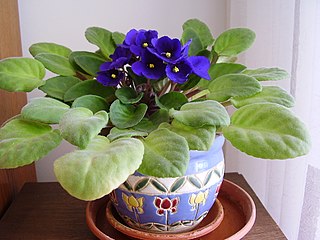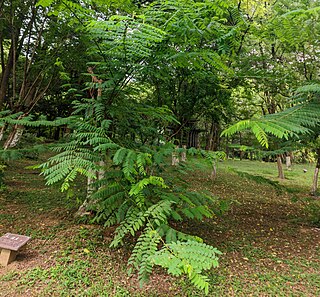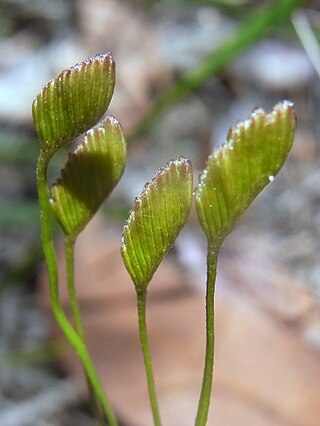
Dioscoreaceae is a family of monocotyledonous flowering plants, with about 715 known species in nine genera. The best-known member of the family is the yam.

Gesneriaceae, the gesneriad family, is a family of flowering plants consisting of about 152 genera and ca. 3,540 species in the tropics and subtropics of the Old World and the New World, with a very small number extending to temperate areas. Many species have colorful and showy flowers and are cultivated as ornamental plants.

Abarema is a neotropical genus in the family Fabaceae. It is native to Brazil, Cuba, and Venezuela. Most of the species can be found in the Amazon Basin and the Guyana Highlands. They have a deep-green fernlike foliage, with bipinnately compound leaves.

The Athyriaceae are a family of terrestrial ferns in the order Polypodiales. In the Pteridophyte Phylogeny Group classification of 2016 (PPG I), the family is placed in the suborder Aspleniineae, and includes two genera. Alternatively, it may be treated as the subfamily Athyrioideae of a very broadly defined family Aspleniaceae. The family has with a cosmopolitan distribution.

Behaimia is a monotypic genus of flowering plants in the family Fabaceae. It is only found in Cuba. It has only one accepted species, Behaimia cubensis. It can be distinguished from related genera, Cyclolobium and Limadendron by:
pinnately multifoliolate leaves, a sessile ovary, and an indehiscent or late dehiscent one-seeded pod.

Zenia is a genus of plants in the family Fabaceae. It belongs to the subfamily Dialioideae. It contains a single species, Zenia insignis. It is a medium-sized tree, 15–20 metres (49–66 ft) tall. It is found in southern China and northern Vietnam. It is threatened by habitat loss and overharvesting. The species is under second-class national protection in China.

Hopea is a genus of plants in the family Dipterocarpaceae. It contains some 113 species, distributed from Sri Lanka and southern India to the Andaman Islands, Myanmar, southern China, and southward throughout Malesia to New Guinea. They are mainly main and subcanopy trees of lowland rainforest, but some species can become also emergent trees, such as Hopea nutans.
Hopea celebica is a species of plant in the family Dipterocarpaceae. It is native to Sulawesi.
Citrus neocaledonica, synonym Oxanthera neocaledonica, the large leaf oxanthera, is a species of plant in the family Rutaceae. It is endemic to New Caledonia.
Citrus undulata, synonym Oxanthera undulata, the wavy-leaf oxanthera, is a species of plant in the family Rutaceae. It is endemic to New Caledonia.

Pamianthe is a genus of South American bulbous perennials in the Amaryllis family, subfamily Amaryllidoideae. They can be found in sandy, but rocky areas in Colombia, Ecuador, Peru, and Bolivia.

Schizaeaceae is a family of ferns in the order Schizaeales. In the Pteridophyte Phylogeny Group classification of 2016, it includes only two genera. Alternatively, two families kept separate in PPG I, Lygodiaceae and Anemiaceae, may be included in Schizaeaceae so that the family has four genera. In this approach, the Schizaeaceae of PPG I is treated as the subfamily Schizaeoideae.
Hesperalbizia is a genus of flowering plants in the family Fabaceae. It belongs to the mimosoid clade of the subfamily Caesalpinioideae. The only species is Hesperalbizia occidentalis. It is native to Mexico and is known by the common name palo escopeta.
Baphiopsis parviflora is an African species of flowering plants in the legume family, Fabaceae. It is the sole species in genus Baphiopsis. It is a shrub or tree which ranges from Cameroon to Tanzania and Angola.
Leucomphalos is a genus of flowering plants in the legume family, Fabaceae. It contains a single species, Leucomphalos capparideus, a climbing perennial shrub native to the Guineo-Congolian forest of Nigeria, Cameroon, Equatorial Guinea, Gabon, and the Gulf of Guinea Islands. It belongs to the subfamily Faboideae. Leucomphalos was traditionally assigned to the tribe Sophoreae; however, recent molecular phylogenetic analyses reassigned Leucomphalos to the Baphieae tribe.
Potoxylon is a monotypic genus of evergreen trees belonging to the Laurel family, Lauraceae. Its only species, Potoxylon melagangai, is endemic to Borneo.

Pterocymbium tinctorium is a tropical forest tree species in the family Malvaceae, subfamily Sterculioideae. In Vietnam, it is known as dực nang nhuộm. In Indonesia, it is called kelumbuk, where it is a significant timber tree growing to about 25 m high. In the Philippines it is called malasapsap.
Lycopodiastrum is a genus of lycophyte in the family Lycopodiaceae with only one species, Lycopodiastrum casuarinoides. In the Pteridophyte Phylogeny Group classification of 2016, the genus is placed in the subfamily Lycopodioideae. Some sources do not recognize the genus, sinking it into Lycopodium. Lycopodiastrum casuarinoides is native to south-eastern Asia, from Tibet through China to Japan in the north, and from Sumatra to Sulawesi in the south.
Papuodendron is a genus of flowering plants belonging to the family Malvaceae. In 1946 Cyril Tenison White described its first species, Papuodendron lepidotum, which was discovered growing in 1944 in the Mandated Territory of New Guinea. Its native range is New Guinea.
Beilschmiedia lucidula is a widespread species of flowering plant in the family Lauraceae, native to the eastern Indian Subcontinent, Indochina, and most of Malesia. It is a tree reaching 30 m (98 ft) tall.











